语言学复习(题目).doc
- 格式:doc
- 大小:61.00 KB
- 文档页数:5
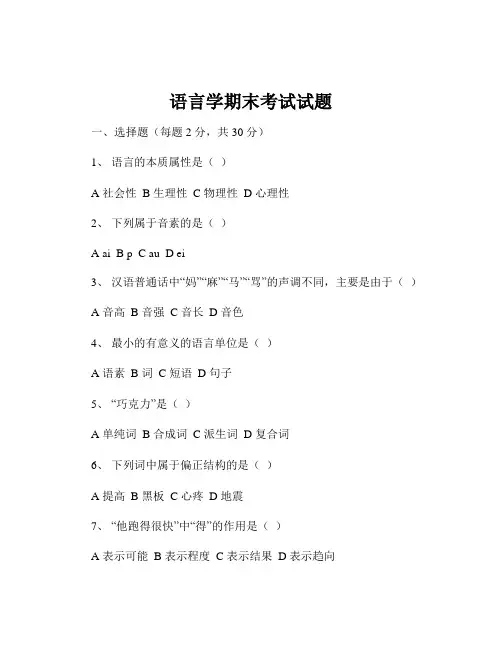
语言学期末考试试题一、选择题(每题 2 分,共 30 分)1、语言的本质属性是()A 社会性B 生理性C 物理性D 心理性2、下列属于音素的是()A aiB pC auD ei3、汉语普通话中“妈”“麻”“马”“骂”的声调不同,主要是由于()A 音高B 音强C 音长D 音色4、最小的有意义的语言单位是()A 语素B 词C 短语D 句子5、“巧克力”是()A 单纯词B 合成词C 派生词D 复合词6、下列词中属于偏正结构的是()A 提高B 黑板C 心疼D 地震7、“他跑得很快”中“得”的作用是()A 表示可能B 表示程度C 表示结果D 表示趋向8、下列句子属于兼语句的是()A 他叫我去买东西。
B 我知道他来。
C 他有个妹妹很可爱。
D 大家选他当班长。
9、下列属于外来词的是()A 电脑B 沙发C 电话D 电视10、语言发展的基本条件是()A 社会的发展B 语言内部的矛盾C 不同语言的接触D 个人的创造11、现代汉民族共同语是以()为标准音。
A 北京语音B 北方语音C 南京语音D 广州语音12、下列方言中属于吴方言的是()A 上海话B 厦门话C 南昌话D 长沙话13、语言融合的方式通常是()A 自愿融合B 被迫融合C 自然融合D 人工融合14、下列语言中属于屈折语的是()A 汉语B 英语C 日语D 朝鲜语15、语言符号的任意性是指()A 语言符号的形式和意义之间没有必然联系B 语言符号的形式和意义之间存在必然联系C 语言符号可以随意改变形式和意义D 语言符号的形式和意义是固定不变的二、填空题(每题 2 分,共 20 分)1、语言是人类最重要的________工具和________工具。
2、语音四要素包括音高、音强、音长和________。
3、元音和辅音最主要的区别是________。
4、词的组合的五种基本类型是主谓结构、动宾结构、偏正结构、中补结构和________。
5、句子按语气可以分为陈述句、疑问句、祈使句和________。
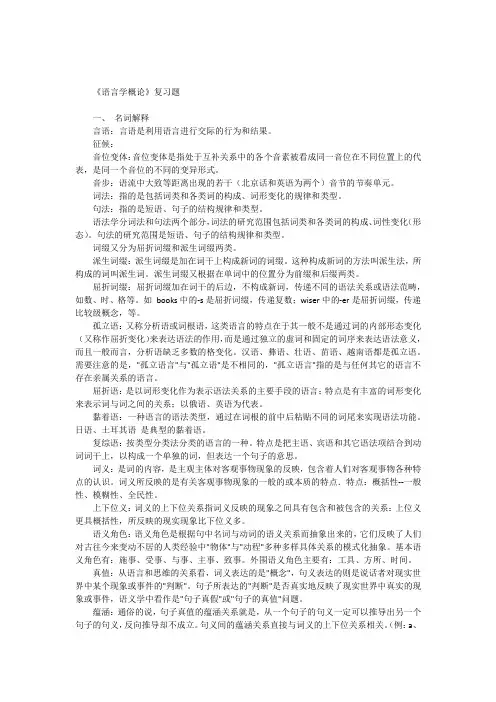
《语言学概论》复习题一、名词解释言语:言语是利用语言进行交际的行为和结果。
征候:音位变体:音位变体是指处于互补关系中的各个音素被看成同一音位在不同位置上的代表,是同一个音位的不同的变异形式。
音步:语流中大致等距离出现的若干(北京话和英语为两个)音节的节奏单元。
词法:指的是包括词类和各类词的构成、词形变化的规律和类型。
句法:指的是短语、句子的结构规律和类型。
语法学分词法和句法两个部分,词法的研究范围包括词类和各类词的构成、词性变化(形态)。
句法的研究范围是短语、句子的结构规律和类型。
词缀又分为屈折词缀和派生词缀两类。
派生词缀:派生词缀是加在词干上构成新词的词缀。
这种构成新词的方法叫派生法,所构成的词叫派生词。
派生词缀又根据在单词中的位置分为前缀和后缀两类。
屈折词缀:屈折词缀加在词干的后边,不构成新词,传递不同的语法关系或语法范畴,如数、时、格等。
如books中的-s是屈折词缀,传递复数;wiser中的-er是屈折词缀,传递比较级概念,等。
孤立语:又称分析语或词根语,这类语言的特点在于其一般不是通过词的内部形态变化(又称作屈折变化)来表达语法的作用,而是通过独立的虚词和固定的词序来表达语法意义,而且一般而言,分析语缺乏多数的格变化。
汉语、彝语、壮语、苗语、越南语都是孤立语。
需要注意的是,"孤立语言"与"孤立语"是不相同的,"孤立语言"指的是与任何其它的语言不存在亲属关系的语言。
屈折语:是以词形变化作为表示语法关系的主要手段的语言;特点是有丰富的词形变化来表示词与词之间的关系;以俄语、英语为代表。
黏着语:一种语言的语法类型,通过在词根的前中后粘贴不同的词尾来实现语法功能。
日语、土耳其语是典型的黏着语。
复综语:按类型分类法分类的语言的一种。
特点是把主语、宾语和其它语法项结合到动词词干上,以构成一个单独的词,但表达一个句子的意思。
词义:是词的内容,是主观主体对客观事物现象的反映,包含着人们对客观事物各种特点的认识。
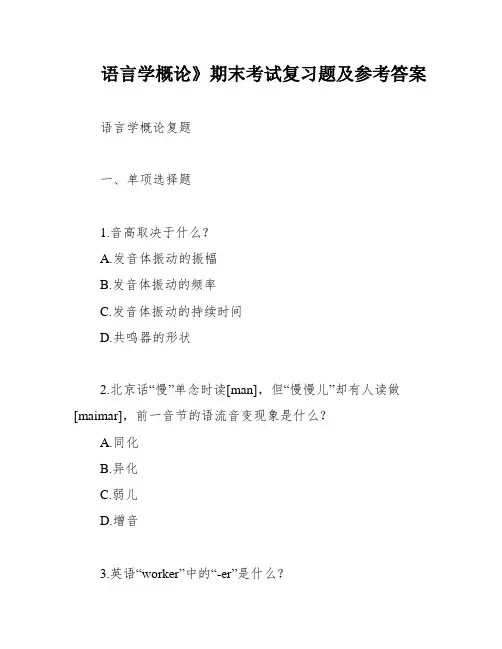
语言学概论》期末考试复习题及参考答案语言学概论复题一、单项选择题1.音高取决于什么?A.发音体振动的振幅B.发音体振动的频率C.发音体振动的持续时间D.共鸣器的形状2.北京话“慢”单念时读[man],但“慢慢儿”却有人读做[maimar],前一音节的语流音变现象是什么?A.同化B.异化C.弱儿D.增音3.英语“worker”中的“-er”是什么?A.构词语素B.构形语素C.虚词语素D.词根语素4.下列汉语词语中的“儿”不属于词根语素(实义语素)的是什么?A.健儿B.女儿C.少儿D.花儿5.“吓唬”和“恐吓”在非理性意义上的主要差别是什么?A.语气意义不同B.感情色彩不同C.语体色彩不同D.形象色彩不同6.“XXX说服了XXX”中“XXX”是行为的施事,“XXX”是行为的受事,这种意义是什么?A.语汇意义B.语法意义C.语境意义D.蕴含意义7.语言成分的借用,最常见、最突出的是什么?A.词语的借用B.语音成分的借用C.词缀的借用D.语法结构的借用8.下列几种类型的社会方言中,具有排他性的是什么?A.行话B.黑话C.官腔D.贵族语言9.下列辅音音素都是XXX的一组是什么?A.[d。
l]B.[b。
k]C.[p。
n]D.[t。
v]10.从语音的社会功能角度划分出来的最小语音单位是什么?A.音位B.音素C.音节D.音渡11.英语“students”中的“-s”是什么?A.虚词语素B.词根语素C.构形语素D.构词语素12.下列现象中不属于词法手段的是什么?A.虚词B.重叠C.轻重音D.词形变化13.下面词组中,结构类型与其他各组不同的一组是什么?A.年轻漂亮/朴素大方B.我们大家/首都北京C.铁路民航/工人农民D.贯彻执行/讨论研究14.下列成对的词语中,属于相对反义词的一组是什么?A.成功—失败B.合法—非法C.本地—外地D.勤劳—懒惰15.造成“北京人多”一句歧义的主要原因是什么?A.一词多义B.不同的句法结构关系C.不同的语义结构关系D.不同的层次构造16.下列关于语言起源的表述中,正确的一项是什么?A.语言产生于人类对外界各种声音的摹仿B.语言产生于人们的相互约定C.语言是人类有意识地在短时间内创造出来的D.语言是人类在长期进化发展过程中创造出来的17.在儿童学会说话的过程中,“双词阶段”标志着儿童已经具备了语法能力,能够组合两个词来表达意思。
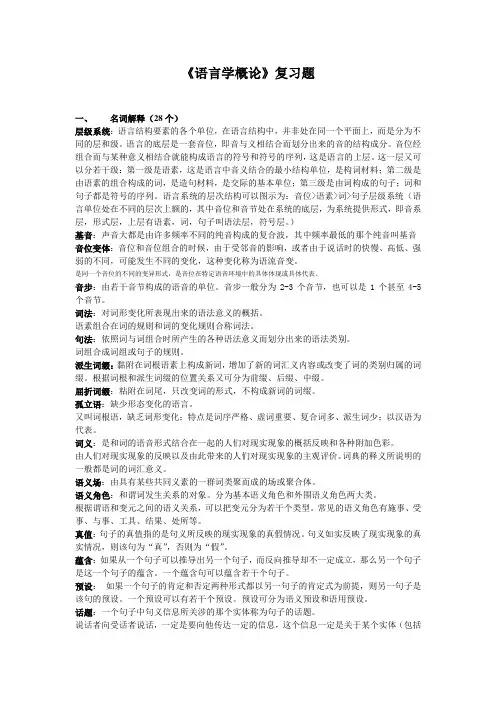
《语言学概论》复习题一、名词解释(28个)层级系统:语言结构要素的各个单位,在语言结构中,并非处在同一个平面上,而是分为不同的层和级。
语言的底层是一套音位,即音与义相结合而划分出来的音的结构成分。
音位经组合而与某种意义相结合就能构成语言的符号和符号的序列,这是语言的上层。
这一层又可以分若干级:第一级是语素,这是语言中音义结合的最小结构单位,是构词材料;第二级是由语素的组合构成的词,是造句材料,是交际的基本单位;第三级是由词构成的句子;词和句子都是符号的序列。
语言系统的层次结构可以图示为:音位>语素>词>句子层级系统(语言单位处在不同的层次上额的,其中音位和音节处在系统的底层,为系统提供形式,即音系层,形式层,上层有语素,词,句子叫语法层,符号层。
)基音:声音大都是由许多频率不同的纯音构成的复合波,其中频率最低的那个纯音叫基音音位变体:音位和音位组合的时候,由于受邻音的影响,或者由于说话时的快慢、高低、强弱的不同,可能发生不同的变化,这种变化称为语流音变。
是同一个音位的不同的变异形式,是音位在特定语音环境中的具体体现或具体代表。
音步:由若干音节构成的语音的单位。
音步一般分为2-3个音节,也可以是1个甚至4-5个音节。
词法:对词形变化所表现出来的语法意义的概括。
语素组合在词的规则和词的变化规则合称词法。
句法:依照词与词组合时所产生的各种语法意义而划分出来的语法类别。
词组合成词组或句子的规则。
派生词缀:黏附在词根语素上构成新词,增加了新的词汇义内容或改变了词的类别归属的词缀。
根据词根和派生词缀的位置关系又可分为前缀、后缀、中缀。
屈折词缀:粘附在词尾,只改变词的形式,不构成新词的词缀。
孤立语:缺少形态变化的语言。
又叫词根语,缺乏词形变化;特点是词序严格、虚词重要、复合词多、派生词少;以汉语为代表。
词义:是和词的语音形式结合在一起的人们对现实现象的概括反映和各种附加色彩。
由人们对现实现象的反映以及由此带来的人们对现实现象的主观评价。
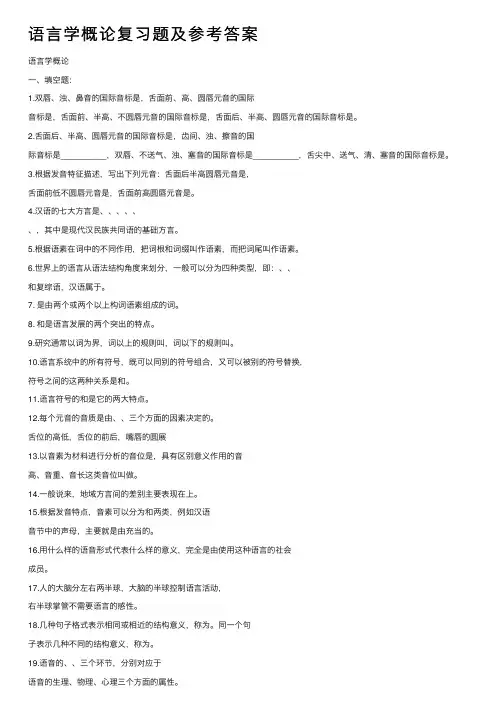
语⾔学概论复习题及参考答案语⾔学概论⼀、填空题:1.双唇、浊、⿐⾳的国际⾳标是,⾆⾯前、⾼、圆唇元⾳的国际⾳标是,⾆⾯前、半⾼、不圆唇元⾳的国际⾳标是,⾆⾯后、半⾼、圆唇元⾳的国际⾳标是。
2.⾆⾯后、半⾼、圆唇元⾳的国际⾳标是,齿间、浊、擦⾳的国际⾳标是__________,双唇、不送⽓、浊、塞⾳的国际⾳标是__________,⾆尖中、送⽓、清、塞⾳的国际⾳标是。
3.根据发⾳特征描述,写出下列元⾳:⾆⾯后半⾼圆唇元⾳是,⾆⾯前低不圆唇元⾳是,⾆⾯前⾼圆唇元⾳是。
4.汉语的七⼤⽅⾔是、、、、、、,其中是现代汉民族共同语的基础⽅⾔。
5.根据语素在词中的不同作⽤,把词根和词缀叫作语素,⽽把词尾叫作语素。
6.世界上的语⾔从语法结构⾓度来划分,⼀般可以分为四种类型,即:、、和复综语,汉语属于。
7. 是由两个或两个以上构词语素组成的词。
8. 和是语⾔发展的两个突出的特点。
9.研究通常以词为界,词以上的规则叫,词以下的规则叫。
10.语⾔系统中的所有符号,既可以同别的符号组合,⼜可以被别的符号替换,符号之间的这两种关系是和。
11.语⾔符号的和是它的两⼤特点。
12.每个元⾳的⾳质是由、、三个⽅⾯的因素决定的。
⾆位的⾼低,⾆位的前后,嘴唇的圆展13.以⾳素为材料进⾏分析的⾳位是,具有区别意义作⽤的⾳⾼、⾳重、⾳长这类⾳位叫做。
14.⼀般说来,地域⽅⾔间的差别主要表现在上。
15.根据发⾳特点,⾳素可以分为和两类,例如汉语⾳节中的声母,主要就是由充当的。
16.⽤什么样的语⾳形式代表什么样的意义,完全是由使⽤这种语⾔的社会成员。
17.⼈的⼤脑分左右两半球,⼤脑的半球控制语⾔活动,右半球掌管不需要语⾔的感性。
18.⼏种句⼦格式表⽰相同或相近的结构意义,称为。
同⼀个句⼦表⽰⼏种不同的结构意义,称为。
20.句⼦按其语⽓可以分为陈述、疑问、祈使、感叹等不同的类型,例如“什么书他都喜欢看”是。
⼆、单项选择题:1.从⾃然属性⾓度划分出来的最⼩语⾳单位是()。
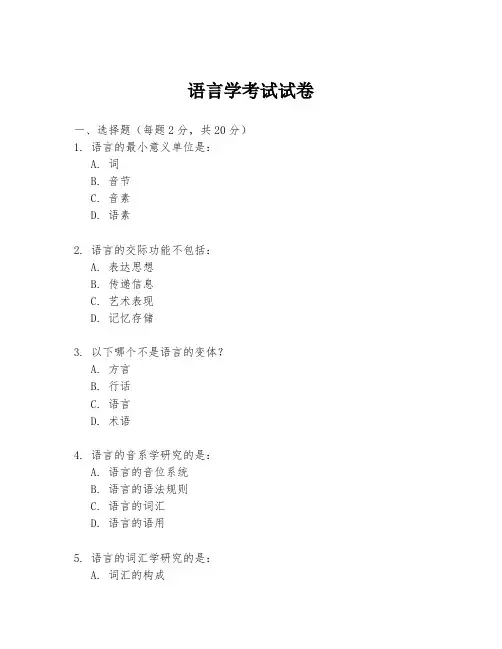
语言学考试试卷一、选择题(每题2分,共20分)1. 语言的最小意义单位是:A. 词B. 音节C. 音素D. 语素2. 语言的交际功能不包括:A. 表达思想B. 传递信息C. 艺术表现D. 记忆存储3. 以下哪个不是语言的变体?A. 方言B. 行话C. 语言D. 术语4. 语言的音系学研究的是:A. 语言的音位系统B. 语言的语法规则C. 语言的词汇D. 语言的语用5. 语言的词汇学研究的是:A. 词汇的构成B. 词汇的意义C. 词汇的发音D. A和B6. 以下哪个是语言的语法结构?A. 词序B. 词形变化C. 句法结构D. A、B和C7. 语言的语用学研究的是:A. 语言的语境B. 语言的交际效果C. 语言的交际策略D. A、B和C8. 以下哪个是社会语言学研究的内容?A. 语言的地域差异B. 语言的社会阶层差异C. 语言的性别差异D. A、B和C9. 语言的演化不包括:A. 语言的扩散B. 语言的简化C. 语言的复杂化D. 语言的消失10. 以下哪个是语言习得的关键期?A. 婴儿期B. 儿童期C. 青春期D. 成年期二、填空题(每空1分,共10分)11. 语言是一种______,它是人类用来交流思想和信息的工具。
12. 语言学中的“同音异义词”指的是发音相同但意义不同的词,例如英语中的“lead”(领导)和“lead”(铅)。
13. 语言的______是语言中最小的可以独立使用的意义单位。
14. 语言的______是指语言在不同社会群体中的使用差异。
15. 语言的______是指语言在不同地理区域中的使用差异。
三、简答题(每题10分,共20分)16. 请简述语言的交际功能。
17. 描述语言学中“语境”的概念及其重要性。
四、论述题(每题15分,共30分)18. 论述语言的音系学和音韵学的区别和联系。
19. 论述社会语言学研究的意义和应用领域。
五、案例分析题(共20分)20. 某地区有A、B两种方言,A方言的使用者主要在城市,B方言的使用者主要在农村。
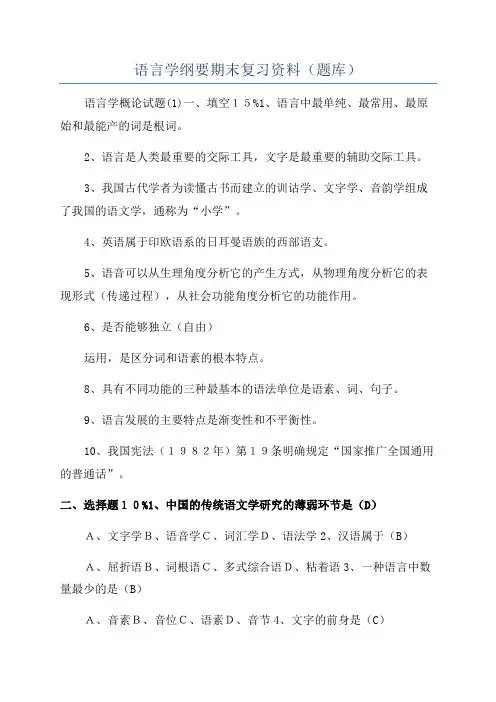
语言学纲要期末复习资料(题库)语言学概论试题(1)一、填空15%1、语言中最单纯、最常用、最原始和最能产的词是根词。
2、语言是人类最重要的交际工具,文字是最重要的辅助交际工具。
3、我国古代学者为读懂古书而建立的训诂学、文字学、音韵学组成了我国的语文学,通称为“小学”。
4、英语属于印欧语系的日耳曼语族的西部语支。
5、语音可以从生理角度分析它的产生方式,从物理角度分析它的表现形式(传递过程),从社会功能角度分析它的功能作用。
6、是否能够独立(自由)运用,是区分词和语素的根本特点。
8、具有不同功能的三种最基本的语法单位是语素、词、句子。
9、语言发展的主要特点是渐变性和不平衡性。
10、我国宪法(1982年)第19条明确规定“国家推广全国通用的普通话”。
二、选择题10%1、中国的传统语文学研究的薄弱环节是(D)A、文字学B、语音学C、词汇学D、语法学2、汉语属于(B)A、屈折语B、词根语C、多式综合语D、粘着语3、一种语言中数量最少的是(B)A、音素B、音位C、语素D、音节4、文字的前身是(C)A、结绳记事B、手势C、图画记事D、实物记事5、派生词中包含(B)A、词尾B、词根C、虚词D、根词6、语音和语义结合的最小的语言单位是(C)A、音素B、义素C、语素D、音位7、汉语单词“忽然”出现的位置是(C)A、主语位置B、谓语位置C、状语位置D、定语位置8、以下各种语言变体中,属于社会方言的是(D)A、土话B、客家话C、客套话D、黑话9、下列语素中属于自由语素的是(C)A、初B、视C、人D、民10、在语言结构的某一环节上能够互相替换,具有某种相同作用的各个单位之间所形成的关系叫(D)A、转换关系B、组合关系C、层级关系D、聚合关系三、名词解释20%1、专语语言学:以具体语言作为研究对象的语言学。
2、组合关系:指两个以上相连续的语言符号组合而成的线性关系。
3、语流音变:语流中的某些音由于相互影响而发生临时性的变化,这种变化就叫语流音变。
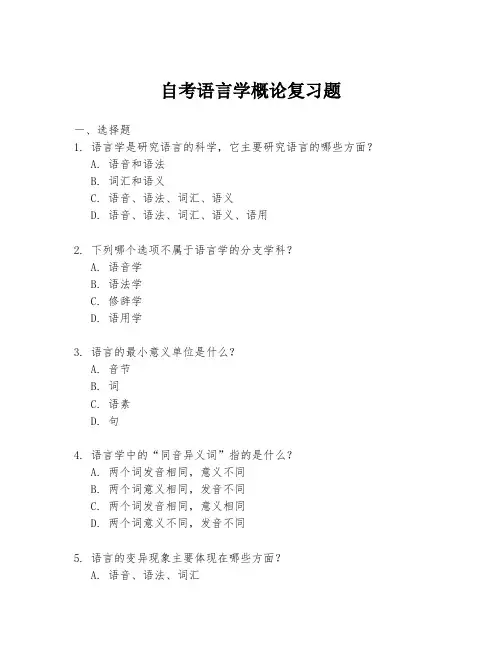
自考语言学概论复习题一、选择题1. 语言学是研究语言的科学,它主要研究语言的哪些方面?A. 语音和语法B. 词汇和语义C. 语音、语法、词汇、语义D. 语音、语法、词汇、语义、语用2. 下列哪个选项不属于语言学的分支学科?A. 语音学B. 语法学C. 修辞学D. 语用学3. 语言的最小意义单位是什么?A. 音节B. 词C. 语素D. 句4. 语言学中的“同音异义词”指的是什么?A. 两个词发音相同,意义不同B. 两个词意义相同,发音不同C. 两个词发音相同,意义相同D. 两个词意义不同,发音不同5. 语言的变异现象主要体现在哪些方面?A. 语音、语法、词汇B. 语法、词汇、语义C. 语音、词汇、语义D. 语音、语法、语用二、填空题6. 语言学的四大分支包括语音学、语法学、_______、_______。
7. 语言的最小意义单位是_______,它能够独立地表达意义。
8. 语言的_______是指语言在不同地区、不同社会群体中的不同表现形式。
9. 语言的功能包括表达思想、交流信息、_______、_______等。
10. 语言学研究的目的是揭示语言的_______,促进语言的学习和使用。
三、简答题11. 简述语言学研究的主要目的和意义。
12. 描述语言的语音系统是如何构成的。
13. 解释什么是语法规则,并举例说明。
14. 阐述词汇和语义之间的关系。
15. 讨论语言变异现象对语言发展的影响。
四、论述题16. 论述语言学在现代科技中的应用及其重要性。
17. 分析语言与文化之间的关系,并举例说明。
18. 探讨语言规划和语言政策对社会发展的影响。
19. 论述语言习得理论对第二语言教学的启示。
20. 讨论语言的交际功能及其在日常生活中的应用。
五、案例分析题21. 请分析下列对话中的语言现象,并解释其语言学意义。
- 对话一:A: “你今天看起来很高兴。
” B: “是的,我通过了考试。
”- 对话二:A: “这本书太难了,我看不懂。
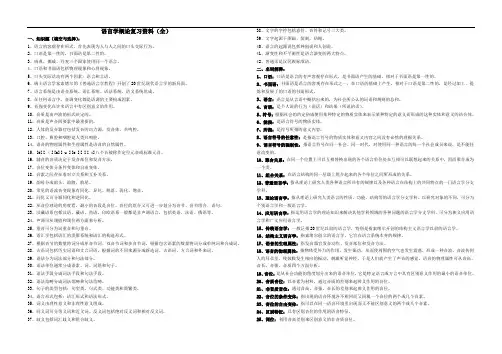
语言学概论复习资料(全)一、知识题(填空与选择):1、语言的客观存在形式,首先表现为人与人之间的口头交际行为。
2、口语是第一性的,书面语是第二性的。
3、瑞典、挪威、丹麦三个国家使用同一个语言。
4、口语和书面语包括物理现象和心理现象。
5、口头交际活动有两个因素:语言和言语。
6、瑞士语言学家索绪尔的《普通语言学教程》开创了20世纪现代语言学的新局面。
7、语言系统是由语音系统、语汇系统、语法系统、语义系统组成。
8、在任何语言中,音调变化都是语调的主要构成因素。
9、音强变化在许多语言中有区别意义的作用。
10、音质是由声波的形式决定的。
11、音质是声音四要素中最重要的。
12、人体的发音器官包括发音的动力源、发音体、共鸣腔。
13、口腔、鼻腔和咽腔是人类共鸣腔。
14、语音的物理属性和生理属性是语音的自然属性。
15、[e][ ε][a][ u ][o ][ ][ ɑ]八个音被称作定位元音或标准元音。
16、辅音的音质决定于发音部位和发音方法。
17、音位变体分条件变体和自由变体。
18、音素之间存在着对立关系和互补关系。
19、韵母分成韵头、韵腹、韵尾。
20、常见的语流音变现象有同化、异化、脱落、弱化、增音。
21、同化又可分顺同化和逆同化。
22、从音位理论的角度看,最小的音段是音位。
音位的组合又可进一步划分为音节、音节组合、语句。
23、汉藏语系包括汉语、藏语、苗语。
印欧语系一般都是非声调语言,包括英语、法语、俄语等。
24、声调可从调值和调位两方面来分析。
25、重音可分为词重音和句重音。
26、语汇学包括语汇的类聚系统和语汇的构造形式。
27、根据音节的数量将词分成单音节词、双音节词和多音节词。
根据包含语素的数量将词分成单纯词和合成词。
28、古语词包括历史词语和文言词语。
根据词的不同来源分成新造词、古语词、方言词和外来词。
29、语法分为词法部分和句法部分。
30、语法单位通常分成语素、词、词组和句子。
31、语法手段分成词法手段和句法手段。

语言学复习题及答案(总21页)--本页仅作为文档封面,使用时请直接删除即可----内页可以根据需求调整合适字体及大小--I. Choose the best answer.1. Language is a system of arbitrary vocal symbols used for human __________A. contactB. communicationC. relationD. community2. Study the following dialogue. What function does it play according to the functions of language—A nice day, isn’t it— Right! I really enjoy the sunlight.A. EmotiveB. PhaticC. PerformativeD. Interpersonal3. __________ refers to the actual realization of the ideal language user’s knowledge of the rules of his language in utterances.A. PerformanceB. CompetenceC. LangueD. Parole4. __________ deals with language application to other fields, particularly education.A. Linguistic theoryB. Practical linguisticsC. Applied linguisticsD. Comparative linguistics5. __________ answers such questions as how we as infants acquire our first language.A. Psycholinguistics linguisticsC. Sociolinguistics D. Applied linguistics6. Pitch variation is known as __________ when its patterns are imposed on sentences.A. intonationB. toneC. pronunciationD. voice7. Conventionally a __________ is put in slashes (/ /).A. allophoneB. phoneC. phonemeD. morpheme8. An aspirated p, an unaspirated p and an unreleased p are__________ of the p phoneme.A. analoguesB. tagmemesC. morphemesD. allophones9. The opening between the vocal cords is sometimes referred to as __________.A. glottisB. vocal cavityC. pharynxD. uvula10. The diphthongs that are made with a movement of the tongue towards the center are known as __________ diphthongs.A. wideB. closingC. narrowD. centering11. A phoneme is a group of similar sounds called __________.A. minimal pairsB. allomorphsC. phonesD. allophones12. Which branch of phonetics concerns the production of speech sounds?A. Acoustic phoneticsB. Articulatory phoneticsC. Auditory phoneticsD. None of the above13. Which one is different from the others according to places of articulation?A. [n]B. [m]C. [ b ]D. [p]14. Which vowel is different from the others according to the characteristics of vowels?A. [i:]B. [ u ]C. [e]D. [ i ]15. What kind of sounds can we make when the vocal cords are vibrating?A. VoicelessB. VoicedC. Glottal stopD. Consonant16. Nouns, verbs and adjectives can be classified as __________.A. lexical wordsB. grammatical wordsC. function wordsD. form words17. Morphemes that represent tense, number, gender and case are called __________ morpheme.A. inflectionalB. freeC. boundD. derivational18. There are __________ morphemes in the word denationalization.A. threeB. fourC. fiveD. six19. In English –ise and –tion are called __________.A. prefixesB. suffixesC. infixesD. stems20. The three subtypes of affixes are: prefix, suffix and __________.A. derivational affixB. inflectional affixC. infixD. back-formation21. __________ is a way in which new words may be formed from already existing words by subtracting an affix which is thought to be part of the old word.A. affixationB. back-formationC. insertionD. addition22. The word TB is formed in the way of __________.A. acronymyB. clippingC. initialismD. blending23. The words like comsat and sitcom are formed by __________.A. blendingB. clippingC. back-formationD. acronymy24. The stem of disagreements is __________.A. agreementB. agreeC. disagreeD. disagreement25. All of them are meaningful except for __________.A. lexemeB. phonemeC. morphemeD. allomorph26. The sentence structure is ________.A. only linearB. only hierarchicalC. complexD. both linear and hierarchical27. The syntactic rules of any language are ____ in number.A. largeB. smallC. finiteD. infinite28. The ________ rules are the rules that group words and phrases to form grammatical sentences.A. lexicalB. morphologicalC. linguisticD. combinational29. A sentence is considered ____ when it does not conform to the grammatical knowledge in the mind of native speakers.A. rightB. wrongC. grammaticalD. ungrammatical30. A __________ in the embedded clause refers to the introductory word that introduces the embedded clause.A. coordinatorB. particleC. prepositionD. subordinator31. Phrase structure rules have ____ properties.A. recursiveB. grammaticalC. socialD. functional32. Phrase structure rules allow us to better understand_____________.A. how words and phrases form sentences.B. what constitutes the grammaticality of strings of wordsC. how people produce and recognize possible sentencesD. all of the above.33. The head of the phrase “the city Rome” is __________.A. the cityB. RomeC. cityD. the city Rome34. The phrase “on the shelf” belongs to __________ constructio n.A. endocentricB. exocentricC. subordinateD. coordinate35. The sentence “They were wanted to remain quiet and not to expose themselves.” is a __________ sentence.A. simpleB. coordinateC. compoundD. complex36. The naming theory is advanced by ________.A. PlatoB. BloomfieldC. Geoffrey LeechD. Firth37. “Can I borrow your bike”_______ “You have a bike.”A. is synonymous withB. is inconsistent withC. entailsD. presupposes38. ___________ is a way in which the meaning of a word can be dissected into meaning components, called semantic features.A. Predication analysisB. Componential analysisC. Phonemic analysisD. Grammatical analysis39. “Alive” and “dead” are ______________.A. gradable antonymsB. relational antonymsC. complementary antonymsD. None of the above40. _________ deals with the relationship between the linguistic element and the non-linguistic world of experience.A. ReferenceB. ConceptC. SemanticsD. Sense41. ___________ refers to the phenomenon that words having different meanings have the same form.A. PolysemyB. SynonymyC. HomonymyD. Hyponymy42. Words that are close in meaning are called ______________.A. homonymsB. polysemiesC. hyponymsD. synonyms43. What essentially distinguishes semantics and pragmatics is whether in the study of meaning _________ is considered.A. referenceB. speech actC. practical usageD. context44. A sentence is a _________ concept, and the meaning of a sentence is often studied in isolation.A. pragmaticB. grammaticalC. mentalD. conceptual45. If we think of a sentence as what people actually utter in the course of communication, it becomes a (n) _________.A. constativeB. directiveC. utteranceD. expressive46. Speech act theory did not come into being until __________.A. in the late 50’s of the 20the centuryB. in the early 1950’sC. in the late 1960’sD. in the early 21st century47. __________ is the act performed by or resulting from saying something; it is the consequence of, or the change brought about by the utterance.A. A locutionary actB. An illocutionary actC. A perlocutionary actD. A performative act48._____ is a branch of grammar which studies the internal structure ofwords and the rules by which words are formed.49.A. Syntax B. Grammar C. Morphology D. Morpheme50. _____ are often thought to be the smallest meaningful units of language by the linguists.A. WordsB. MorphemesC. PhonemesD. Sentences51.“-s” in the word “books” is _______.52.A. a derivative affix B. a stem C. an inflectional affix D. aroot53. Bound morphemes are classified into two types: ___ affix ____ and __bound root________.54. The theory of __________ condition explains the fact that noun phrases appear only in subject and object positions.55. ___________ refers to the phenomenon that words having different meanings have the same form.A. PolysemyB. SynonymyC. HomonymyD. Hyponymy56. The grammaticality of a sentence is governed by _______.A. grammatical rulesB. selectional restrictionsC. semantic rulesD. semantic features57. What essentially distinguishes semantics and pragmatics is whether in the study of meaning _________ is considered.A. referenceB. speech actC. practical usageD. context58. A sentence is a _________ concept, and the meaning of a sentence is often studied in isolation.A. pragmaticB. grammaticalC. mentalD. conceptual59. If we think of a sentence as what people actually utter in the course of communication, it becomes a (n) _________.A. constativeB. directiveC. utteranceD. expressive60. Which of the following is trueA. Utterances usually do not take the form of sentences.B. Some utterances cannot be restored to complete sentences.C. No utterances can take the form of sentences.D. All utterances can be restored to complete sentences.65. Speech act theory did not come into being until __________.A. in the late 50’s of the 20the centuryB. in the early 1950’sC. in the late 1960’sD. in the early 21st century66. __________ is the act performed by or resulting from saying something; it is the consequence of, or the change brought about by the utterance.A. A locutionary actB. An illocutionary actC. A perlocutionary actD. A performative act67. According to Searle, the illocutionary point of the representative is ______.A. to get the hearer to do somethingB. to commit the speaker to something’s being the caseC. to commit the speaker to some future course of actionD. to express the feelings or attitude towards an existing state of affairs68. All the acts that belong to the same category share the same purpose, but they differ __________.A. in their illocutionary actsB. in their intentions expressedC. in their strength or forceD. in their effect brought about69. __________ is advanced by Paul GriceA. Cooperative PrincipleB. Politeness PrincipleC. The General Principle of Universal GrammarD. Adjacency Principle70. When any of the maxims under the cooperative principle is flouted, _______ might arise.A. impolitenessB. contradictionsC. mutual understandingD. conversational implicatures71. The person who is often described as “father of modern linguistics” is __________..A. FirthB. SaussureC. HallidayD. Chomsky72. The most important contribution of the Prague School to linguistics is that it sees language in terms of __________.A. functionB. meaningC. signsD. system73. The principal representative of American descriptive linguistics is__________.A. BoasB. SapirC. BloomfieldD. Harris74. Generally speaking, the __________ specifies whether a certain tagmeme is in the position of the Nucleus or of the Margin in the structure.A. SlotB. ClassC. RoleD. Cohesion75. __________ Grammar is the most widespread and the best understood method of discussing Indo-European languages.A. TraditionalB. StructuralC. FunctionalD. Generative76. __________ Grammar started from the American linguist Sydney M. Lamb in the late 1950s and the early 1960s.A. StratificationalB. CaseC. RelationalD. Montague77. In Halliday’s view, the __________ function is the function that the child uses to know about his surroundings.A. personalB. heuristicC. imaginativeD. informative78. The rheme in the sentence “On it stood Jane” is __________.A. On itB. stoodC. On it stoodD. Jane79. Chomsky follows __________ in philosophy and mentalism in psychology.A. empiricismB. behaviorismC. relationalismD. mentalism80. TG grammar has seen __________ stages of development.A. threeB. fourC. fiveD. sixII. Explain the following terms, using examples.1. linguistics2. competenceCompetence: It is an essential part of performance. It is the speaker’s knowledge of his or her language; that is, of its sound structure, its words, and its grammatical rules. Competence is, in a way, anencyclopedia of language. Moreover, the knowledge involved in competence is generally unconscious. A transformational-generative grammar is a model of competence.3. Synchronic linguisticsSynchronic linguistics: It refers to the study of a language at a given point in time. The time studied may be either the present or a particular point in the past; synchronic analyses can also be made of dead languages, such as Latin. Synchronic linguistics is contrasted with diachronic linguistics, the study of a language over a period of time.4. Sound assimilationSound assimilation: Speech sounds seldom occur in isolation. In connected speech, under the influence of their neighbors, are replaced by other sounds. Sometimes two neighboring sounds influence each other and are replaced by a third sound which is different from both original sounds. This process is called sound assimilation.5. AllomorphAllomorph: It is any of the variant forms of a morpheme as conditioned by position or adjoining sounds.6. phonology7. SyntaxSyntax: Syntax refers to the rules governing the way words are combined to form sentences in a language, or simply, the study of the formation of sentences.8. referential theory9. PerformativePerformative: In speech act theory an utterance which performs an act, such as Watch out (= a warning).10. Locutionary actLocutionary act: A locutionary act is the saying of something which is meaningful and can be understood.11. phonetics12. Complementary distributionComplementary distribution: The different allophones of the same phoneme never occur in the same phonetic context. When two or more allophones of one phoneme never occur in the same linguistic environment they are said to be in complementary distribution.13. displacement14. sociolinguisticssociolinguistics: Defined in its broadest way, sociolinguistics, a subdiscipline of linguistics, is the study of language in relation to society. It is concerned with language variation, language use, the impact of extra-linguistic factors on language use, etc.15 Phoneme20 assimilation21 synonymy22 semanticsIII. Decide whether the following statements are true or false.1. The air stream provided by the lungs has to undergo a number of modification to acquire the quality of a speech sound. T2. Two sounds are in free variation when they occur in the same environment and do not contrast, namely, the substitution of one for the other does not produce a different word, but merely a different pronunciation. T3. [p] is a voiced bilabial stop. F4. In most cases, the number of syllables of a word corresponds to the number of morphemes. F5. Back-formation is a productive way of word-formations. F6. Inflection is a particular way of word-formations. F7. In English syntactic analysis, four phrasal categories are commonly recognized and discussed, namely, noun phrase, verb phrase, infinitive phrase, and auxiliary phrase. F8. In English the subject usually precedes the verb and the direct object usually follows the verb. T9. What is actually internalized in the mind of a native speaker is a complete list of words and phrases rather than grammatical knowledge. F10. A noun phrase must contain a noun, but other elements are optional. T11. The meaning of a sentence is the sum total of the meanings of all its components. F12. Most languages have sets of lexical items similar in meaning but ranked differently according to their degree of formality. T13. “It is hot.” is a no-place predication because it contains no argument. T14. In grammatical analysis, the sentence is taken to be the basic unit, but in semantic analysis of a sentence, the basic unit is predication, which is the abstraction of the meaning of a sentence. T15. Pragmatics treats the meaning of language as something intrinsic and inherent. F16. The meaning of a sentence is abstract, but context-dependent. F17. Utterances always take the form of complete sentences F18. Speech act theory was originated with the British philosopher John Searle. Fmade the distinction between a constative and a performative. T20. Language is a means of verbal communication. Therefore, the communication way used by the deaf-mute is not language.F21. Speech and writing came into being at much the same time in human history. F22. All the languages in the world today have both spoken and written forms. F23. Only human beings are able to communicate. F24. F. de Saussure, who made the distinction between langue and parole in the early 20th century, was a French linguist. FIV. Fill in the blanks.1. Language, broadly speaking, is a means of __verbal _communication.2. Saussure put forward two important concepts. ___ _______ refers to the abstract linguistic system shared by all members of a speech community.3. Language has many functions. We can use language to talk about itself. This function is metalingual function .4. The description of a language as it changes through time is a _ diachronic linguistic__. ___ study.5. Consonant sounds can be either ___voiced. ______ or __voiceless _ ___, while all vowel sounds are voiced.6. Consonant sounds can also be made when two organs of speech in the mouth are brought close together so that the air is pushed out between them, causing __ friction ___.7. The qualities of vowels depend upon the position of the __tongue ________ and the lips.English there are a number of _ diphthongs ___, which are produced by moving from one vowel position to another through intervening positions.9. Phonemes is the smallest linguistic unit.10. Speech takes place when the organs of speech move to produce patterns of sound. These movements have an effect on the __ air stream __ coming from the lungs.11. Lexicon, in most cases, is synonymous with _ vocabulary .12. All words may be said to contain a root ___morpheme _.13. Words are divided into simple, compound and derived words on the _morpheme level.14. A word formed by derivation is called a _derivative _ __, and a word formed by compounding is called a ___compound _ .15. A ___simple __ sentence consists of a single clause which containsa subject and a predicate and stands alone as its own sentence.16.A __ subject __ may be a noun or a noun phrase in a sentence thatusually precedes the predicate.17. A __complex _ __ sentence contains two, or more, clauses, one of which is incorporated into the other.18. In the complex sentence, the incorporated or subordinate clause is normally called an _ embedded _ clause.19. Major lexical categories are __open _ __ categories in the sense that new words are constantly added.20. The theory of _ _Case ____ condition explains the fact that noun phrases appear only in subject and object positions.21. __Semantics ___ can be defined as the study of meaning.22. The conceptualist view holds that there is no __ direct ____ link between a linguistic form and what it refers to.23. Reference ___ means what a linguistic form refers to in the real, physical world; it deals with the relationship between the linguistic element and the non-linguistic world of experience.24. Words that are close in meaning are called __ synonyms __.25. When two words are identical in sound, but different in spelling and meaning, they are called homophones .26. The Prague School practiced a special style of __synchronic________ Linguistics.27. The Prague School is best known and remembered for its contribution to phonology and the distinction between __phonetics________ and phonology.28. The man who turned linguistics proper into a recognized distinct academic subject in Britain was ___J. R. Firth _______.29. Halliday’s Systemic Grammar contains a functiona l component, and the theory behind his Functional Grammar is __systemic ________. 30. Systemic-Functional Grammar is a(n) __sociologically ________ oriented functional linguistic approach.31. Structuralism is based on the assumption that grammatical categories should be defined not in terms of meaning but in terms of___distribution _______.32. In the history of American linguistics, the period between 1933 and 1950 is also known as __Bloomfieldian ________ Age.33. ___Descriptivism _______ in language theories is characteristic of America.34. The starting point of Chomsky’s TG grammar is his ___ innateness _______ hypothesis.35. Chomsky argues that LAD probably consists of three elements, that is a ___hypothesis-maker _______, linguistic universal, and an evaluation procedure.V. Give the description of the following consonants and vowels in English [p] [b] [s] [z] [d] [k] [l] [t] [m] [h] [g] [j][u:] [ e ] [ ə: ] [ i: ] [ɔ: ] [æ] [ɜ: ] [ɑ: ]VI.Draw a tree diagram of the following sentences.1.The boy ate the apple.2.Mother gave a doll to my sister.3.Mother gave my sister a doll4.I read a interesting book.VII.Answer the following questions.1.The following conversational fragments is to some degree odd. Towhat extent can the oddness be explained by reference to Grice’s CP and what extent can the oddness be explained by reference toGrice’s CP and maximsA: When is the bus coming?B: There has been an accident further up the road.Yes, B is cooperative. On the face of it, B’s statement is not an answer to A’s question. B doesn’t say “when.” However, A will immediately interpret the statement as meaning “I don’t know” or “I am not sure.” Just assume that B is being “relevant” and “informative.” Given that B’s answer contains relevant information, A can work out that “an accident further up the road” conventionally involves “traffic jam,” and “traffic jam” preludes “bus coming.” Thus, B’s answer is not simply a statement of “when the bus comes”; it contains an implicature concerning “when the bus co mes.”2.Explain the following remarks with examples or make somecomments. “Both semantics and pragmatics are concerned withmeaning, but the difference between them can be traced to twodifferent uses of the verb mean: (a) What does X mean (b) What did you mean by X”Pragmatics is the study of the use of language in communication, particularly the relationships between sentences and the contexts and situations in which they are used. Pragmatics includes the study of (1) How the interpretation and use of utterances depends on knowledge of the real world; (2) How speakers use and understand speech acts;(3) How the structure of sentences is influenced by the relationship between the speaker and the hearer. Pragmatics is sometimes contrasted with semantics, which deals with meaning without reference to the users and communicative functions of sentences.3.Can you make a brief introduction to some important schools andtheir influential representatives in modern linguistics4. How many types of morphemes are there in the English languageWhat are they5.What are endocentric construction and exocentric constructionAn endocentric construction is one whose distribution is functionally equivalent, or approaching equivalence, to one of its constituents, which serves as the center, or head, of the whole. A typical example is the three small children with children as its head. The exocentric construction, opposite to the first type, is defined negatively as a construction whose distribution is not functionally equivalent to any of its constituents. Prepositional phrasal like on the shelf are typical examples of this type.。
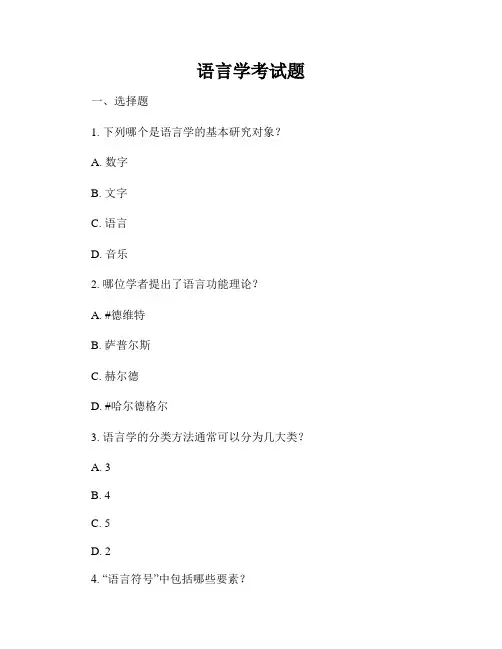
语言学考试题一、选择题1. 下列哪个是语言学的基本研究对象?A. 数字B. 文字C. 语言D. 音乐2. 哪位学者提出了语言功能理论?A. #德维特B. 萨普尔斯C. 赫尔德D. #哈尔德格尔3. 语言学的分类方法通常可以分为几大类?A. 3B. 4C. 5D. 24. “语言符号”中包括哪些要素?A. 声音B. 符号C. 拼写D. A、B5. 在语法范畴中,“动宾关系”是指什么?A. 主语和谓语之间的语法关系B. 主语和宾语之间的语法关系C. 宾语和谓语之间的语法关系D. 主语和动词之间的语法关系二、填空题6. 语言学中研究音素的学科是---。
7. 没有逻辑意义的音节称为---。
8. 语音学的基本单位是---。
9. 下列哪个不是语言学的分支学科?10. 一种语言中声母、韵母和声调三者综合的组合称为---。
三、简答题11. 请简要说明音韵学和语音学的区别。
12. 什么是“方言”,方言和语言的关系是什么?13. 什么是语法,语法的作用是什么?14. “文字和语言的关系”是语言学中一个重要问题,请简述你对这个问题的理解。
15. 请简要介绍语言学的研究方法有哪些?四、论述题16. 语言是人类最重要的交流工具之一,请说明语言对个体和社会的重要性。
17. 语言学的发展历程是怎样的?过去、现在和未来的语言学会有怎样的发展趋势?18. 请解释语言与文化之间的关系,并谈谈语言多样性对世界文化的重要影响。
以上便是本次语言学考试题的全部内容,请同学们认真地完成每一道题目,祝大家取得优异的成绩!。
语言学纲要的复习资料第一章1、三大发源地()()()2、语言学是()世纪成为独立学科,其标志是()的出现3、现代语言学的标志是瑞士语言学家()4()、被誉为“世界上最完备的语法书”5、我国传统语言学包括()()()6、结构主义的三大分支()()()7、语言的分类一般从两个方面进行分类①()②()8、美国结构主义的代表人物()著作()9、与理论语言学相对的是()与外部语言学相对的是()与具体语言学相对的是()(二)判断题1、世界上使用人口最多的语言是英语,使用范围最广的是汉语()2、语言学主要研究古代的口语和书面语()3、历史比较语言学的出现标志着语言学成为一门独立的学科()4、第一个对语言进行谱系分类的是德国语言学家()1、下列说法正确的是【D】A 语言是一种心理现象B 语言是一种具有阶级性的特殊的社会现象C 没有语言,利用文字照样可以进行交际D 在语言的辅助性交际工具中,文字是最重要的。
2、一个英国小孩从小在中国长大,结果他只会讲汉语而不会英语【C】社会具有阶级性3、任意性特点说明了【D】语言是一种特殊的社会现象。
4语言符号层级性的核心是【A】以少聚多5、语言成分按线性次序组合起来【B】组合关系6、下列说法不正确的是【D】语言符号不可以拆卸拼装,不具有生命力7、{组合关系}选不足,改革8、人类语言和动物的交际方式【B】有着根本的区别9、思维不依赖与语言【✘】10、下列观点属于探索语言起源的是【BCD】11、原始语言特点说法正确的是【ABC】12、下列组合关系和聚合关系表述正确的是【ACDE】A 语言成分的聚合类下限于词类。
B 组合关系体现为聚合类的线性序列C 聚合关系是在组合关系中体现出来的D 组合关系可以体现为互相关联的语言单位组成的整体中。
13、下列语言符号与现实现象之间的关系表述正确的是【BDE】判断题14、符号的形式和意义是具有一般性【✔】15、语言是丰富人的心理现实的重要途径【✔】16、现实中的句子是无穷的,所以自合关系也是无限的【✘】17、音位和音位组合构成的语素【✘】18、语言符号可以拆卸拼装,重复使用【✔】19、符号和自己所代表的事物之间具有必然的联系【✘】20、语言与言语之间的关系是一般与个别的关系【✔】21、书刊的话语不是人际互动功能【✘】22、语言在文字的基础上产生人类最重要的交际工具(✘)23.现代社会沟通方式很多,语言重要性日渐衰落{✘}24.工人有工人语言,农民有农民语言。
《语言学概论》课程复习资料一、单项选择题:1.抽象思维的能力和灵活的发音能力相结合,表现为 [ ]A.聪明的才智B.潜在的能力C.人类的语言能力D.超级智慧2.语言是一种 [ ]A.自然现象B.个人现象C.社会现象D.正常现象3.语法的组合规则包括 [ ]A.词法和句法B.构词法和语法范畴C.句法和形态D.内部屈折和词序4.在语言学中,“pidgin”这个单词是指 [ ]A.鸽子B.洋泾浜C.商业D.外来语5.英语的 beer,汉语译为“啤酒”,这种类型的外来词叫做 [ ]A.音译B.意译C.音译加意译D.仿译6.把现代汉语第三人称代词写成“他”、“她”。
[ ]A.表示性的范畴B.表示格的范畴C.并不是表示性的范畴D.表示体的范畴7.汉藏语系诸语言表示语法关系多用( ),这是它们在结构类型上的共同特点之一。
[ ]A.声调B.重音C.词序和虚词D.词的形态变化8.现代汉语的“葡”和“玻” [ ]A.两个都是词B.两个都不是词C.前一个是词,后一个不是词D.后一个是词,前一个不是词9.藏语、维吾尔语、法语三种语言所属的语法结构类型按次序是 [ ]A.粘着语—屈折语—孤立语B.孤立语—粘着语—屈折语C.孤立语—屈折语—粘着语D.屈折语—孤立语—粘着语10.[p‘]、[t‘]、[k‘]三个音素的区别是( )不同。
[ ]A.发音方法B.清浊C.发音部位D.送气与否11.英语的重音是一种 [ ]A.音质音位B.非音质音位C.时位D.音位变体12.“雪花”和“花钱”的两个“花”的关系是 [ ]A.一词多义B.同音词C.同义词D.反义词13.词和句子都是 [ ]A.符号B.顺序C.符号的序列D.音标14.在社会变动较大或政治斗争激烈时,语言各构成要素中变化最大的是 [ ]A.语音B.词汇C.语法D.词义15.英语里的 football,汉语译为“足球”,这种类型的外来词叫做 [ ]A.音译词B.借词C.仿译词D.音译加意译16.词干 [ ]A.就是词根B.不是词根,但只能由词根构成C.可以由词根和词缀构成,不包括词尾D.由词根、词尾、词缀构成17.语言本身的性质和特点表现为 [ ]A.语言是人类最重要的交际工具B.语言是符号系统C.语言是思维工具D.语言是一种特殊的社会现象18.元音和辅音最本质的区别是 [ ]A.声带是否振动B.是否均衡紧张C.时间延续久暂D.气流是否受阻19.“拿一把锁把门锁上。
《语言学概论》期末考试复习题一、填空题。
1.语言的底层是___一套音位___,语言的上层是___音意结合的符号和符号序列____。
2.北京话〔ts、ts`、s〕聚合成群依据的区别特征是__塞擦音___。
3.具有“受一定条件限制、时间性、地区性”三个明显特点的是_语音__演变的规律。
4.新事物、新概念的出现,要求语言必须丰富其__词汇___,而人们思维的愈加细密,则要求语言改进__语法__。
5.根据语素在词中的不同作用,一般把词根和词缀叫作构词语素,把词尾叫作构形语素。
6.__历史比较语言学___的建立,使语言学摆脱了过去的附庸地位,成为一门独立发展的科学。
7.语言符号的形式是__声音___,语言符号的内容是__意义__。
8.语言发展有两个特点:_渐变性__和_不平衡性___。
9.文字起源于__图画和契刻___。
10.中国、印度和希腊—罗马是语言学的三大发源地。
11.洋泾浜和混合语都是语言接触的一些特殊形式。
.12.声音具有音高__、_音重__、__音长__、_音质__这四种声学特征。
13.基本词汇有三个特点:_全民常用__、__稳固__、_有构词能力__。
14.词汇的发展变化大致包括_ 新词产生和旧词消亡__、_词语的替换____、_词义的演变__。
15.借词虽然音义都借自外语,但语音、语法上还得服从本族语言的结构规则。
16汉字的简化和整理异体字,属于文字的改进。
17. 语言系统中的所有符号,既可以同别的符号组合,又可以被别的符号替换,符号之间的这两种关系是组合关系和聚合关系。
18.词汇系统的演变具体表现在词义的扩大、缩小、_____转移___。
19.文字学、音韵学和训诂学是我国传统的语文学。
20. “金陵”现称“南京”,“戏子”现称“演员”,这种变化是词语的替换。
二、选择题1.一般说来,新词、古词、方言词、行业词和外来词等()。
A.属于一般词汇B.属于基本词汇C.有的属于基本词汇,有的属于一般词汇D.有时属于基本词汇,有时属于一般词汇2.口腔中最为灵活的发音器官是()。
语言学概论(八)期末考试复习题及参考答案一、单选题1.(2分)语言符号的任意性是指A.语言符号可以任意使用和创造B.绝大多数语言符号的能指和所指之间没有必然的理据关系C,可以任意使用语言符号绐事物命名D∙语言符号的能指和所指可以任意改变参考答案:B2.(2分)下列各组辅音中,发音部位相同的•组是A.image1..pngB.image2.pngC.image3.pngD.Image4.png参考答案:B3.(2分)“汽车”和“轿车”是A.上下位词B.同义词C.等义词D.近义词参考答案,A4.(2分)下列几种社会方言中,具有排他性的一项是A.阶级习惯语B.行话C隐语D.学生腔参考答案:C5.(2分)下列关于亲属语言的表述中,不正确的项是A亲属语言是社会完全分化的产物B∙亲属语言之间具有历史同源关系C.语言亲属关系有亲疏远近的分别D.亲属语言间不存在语音对应关系参考答案:D6..(2分)“老郎鼓励我考大学”是A.生谓诃组B.兼语词组C.连动词组D.复句词组参考答案,B7.12分)目前己知的最古老的拼音文字是一A.古埃及文字8.占希腊文字C腓尼基文字D∙中国的甲骨文参考答案:C9.(2分)划分词类的最本质的标准是A.分布标准8.意义标准C.形态标准D逻辑标准参考答案,A9.(2分)外语学习中的后期阶段被称为A.中介语阶段B.目标语阶段C低平期D高原期参考答案I D10.(2分)英语“students"中的"∙s"是.A.虚词语素B∙词根语素C.构形语素D.构词语素参考答案:C11.(2分)认为“思维和语言各自发展,二者没仃关系”的学者不包括A.古希腊哲学家柏拉图B.法国哲学家迪卡尔C.英国哲学家座布斯D.苏联语言学家马尔参考答案:D12.(2分)以卜.不属于语言学的三大发源地的是A.中国B.埃及C.印度D希腊•罗马参考答案,B13.(2分)下列语言学流派中桀中研究语言本体的流派是A.功能语言学B∙社会语言学C认知语言学D.结构语言学春考答案:D14.(2分)下面词组中,结构类型与其他各组不同的•组是A.年轻漂亮/朴素大方B.我们大家/首都北京C.民航大厦/工人农民D.贯彻执行/讨论研究辨考答案:C15.(2分)关于语言获得的原因,卜列学说中偏重于内部条件解择的一项是A.天赋说B.摹仿说C强化说D剌激反应说参考答案;A16.(2分)传统上把汉字的单纯字符称为A偏旁B笔画C记号D.独体字参考答案,D17.(2分)北京话“面”单念时读作但“面包”却读作[mi?mpau),这种语流音变现象是A溺化B.增音C同化D.异化春考答案:C18.(2分)汉语中的词类(词的语法分类)可以首先分出的两个大类是一A.基本词和非基本词B.实诃和虚词C.典型词和兼类词D.体词和谓词参考答案:B19.(2分)目前对于语言和思维的关系,比较一致的观点是A.有什么样的思维,就有什么样的语言B∙有什么样的语言,就有什么样的思维C思维对语言有•定影响,但更重要的是语言决定思维D.语言对思维有一定影响,但更重要的是思维决定语言参考答案,D20.(2分)听觉上最自然、最容易分辨的最小语音单位是A.音素B.国i音C音位D.音节参考答案:D21.(2分)首先提出“能指”和“所指”这对概念的语言学家是A洪堡特B.索绪尔D.萨丕尔分考答案:B22.(2分)判断两种话是不同语言还是同一种语言的不同方言应该主要参考A.相互理解程度B.语言结构的差异程度C.共同的历史文化传统和民族认同感D∙地域临近程度参考答案,C23.(2分)语言符号具有可变性的根本原因在丁语言符号的A.任意性B.强制性C离散性D.系统性参考答案:A24.(2分)下列各项中,谓词和变元之间属于动作与结果关系的是A.写黑板B.打篮球C.织毛衣D.寄包裹参考答案,C25.(2分)从词的构造类型上看,汉语“动人”一词属于A.单纯词B.复合词D.简缩词参考答案:B26.(2分)语法的演变之所以比语汇缓慢,是因为A语法规则比较简单B.语法规则数量较少C.语法规则具有强制性D∙语法规则具有抽象性参考答案IC27.(2分)构形语素属于A.虚词语素B.词根语素C.自由语素D.黏若语素参考答案:D28.(2分)下列各组中,三个复合词构词类型不一致的一组是A.席卷耳鸣地震B.打倒切断推翻C发光散热出气D.天地欢乐爱好弁考答案:A29.(2分)在语言谱系分类的层级体系中,域大的类别是一A.语族B.语支C.语系D∙语群参考答案,C30.(2分)从语音的社公功能角度划分出来的最小语音单位是A.音位B.音素C.音节D.各渡参考答案:B31.(2分)人类语言和动物的交际方式A.完全一致B.有根本区别C有•定的差别D∙基本一样参考答案:B32.(2分)“我知道你很聪明。
(二)填空1.古印度、古代中国、古希腊具有悠久的历史文化传统,是语言学的三大发源地。
2.文言是我国古代的书面语,用它写成的文章称为文言文。
3.文字学、音韵学、训诂学是我国传统的语文学。
4.研究语言的结构,主要是研究语音、词汇、语法三个部分。
5.运用语言传递信息的过程,可以分为编码、发送、传递、接收、解码五个阶段。
二、填空题1.人和动物的区别是人会制造工具,而且人类有语言,这人和动物相区别的重要标志之一。
2.一种语言中的句子数量是无限的,人类之所以能掌握语言,是因为构成句子的语法规则是十分有限的。
3.语言是人类社会的最重要的交际工具,而且也是思维的最有效的工具。
4.在一定条件下,身体姿势等伴随动作还可以离开语言独立完成交际任务。
例如汉民族点头表示同意,摇头表示不同意,送别时挥手表示致意,鼓掌表示欢迎,咬牙切齿表示愤恨,手舞足蹈表示激动或高兴。
5.人的大脑分左右两半球,大脑的左半球控制语言活动,右半球掌管不需要语言的感性思维。
6.汉语的哥哥、弟弟,英语用brother 表示,汉语的舅妈、姨妈、姑妈、婶婶,英语用aunt 表示。
7.英语可以直接用数词修饰名词,汉语数词修饰名词一般要加上一个量词。
8.儿童最早的智力活动就是学习语言。
三、判断题1.语言是人类最重要的交际工具。
(+)2.文字也是人类最重要的交际工具。
(-)3.语言是人类特有的,动物没有语言。
(+)4.没有语言,人类照样可以思维。
(-)二、填空题1.任何符号,都是由能指和所指两个方面构成的。
2.语言符号是能记和所记的统一体,声音是语言符号的能记。
3.用什么样的语音形式代表什么样的意义,完全是由使用这种语言的社会成员约定俗成。
4.语言符号具有音义结合的任意性和能指组合的线条性特点。
5.语言的底层是一套音位,上层是符号和符号的组合,可以分为若干级,第一级是词,第二级是词组,第三级是句子。
6.语言系统中的所有符号,既可以同别的符号组合,又可以被别的符号替换,符号之间的这两种关系是组合关系和聚合关系。
语言学全部习题1. 简答题(每题10分,共30分)1) 什么是语言学?语言学是研究语言的科学,包括语音学、词法学、句法学、语义学、语用学等不同的分支。
它关注语言的结构、用法、演变以及和思维、社会和文化之间的关系。
2) 语言的基本要素包括哪些?语言的基本要素包括语音、词汇、句法、语义和语用。
语音研究发音和音系,词汇研究词的形态和词义,句法研究语言的句子结构,语义研究词和句的含义,语用研究语言的使用和交际。
3) 语音学和音系学有何区别?语音学研究语言中的语音现象,包括语音的产生、传播和感知等方面。
音系学研究语言中的音素系统,即语言中所有可能出现的音位和它们的组合规则。
2. 选择题(每题10分,共40分)1) 下列哪个不属于语言的基本要素?A. 语音B. 词汇C. 句法D. 语文答案:D2) 以下哪个学科不是语言学的分支?A. 语音学B. 语用学C. 数学D. 词法学答案:C3) 语音学主要研究哪方面的内容?A. 词义B. 词形C. 词语的使用D. 语音的产生和感知答案:D4) 以下哪个不是语言学的研究对象?A. 词汇表B. 句子结构C. 语言和思维的关系D. 社会语言规范答案:A3. 简答题(每题10分,共30分)1) 什么是语言的演变?语言的演变是指语言在使用过程中,由于多种因素的影响,其语音、词汇、句法等方面发生变化和发展。
语言的演变是一个长期的、渐进的过程,涉及到语言交流者的语言习惯、语音产生的方式、语法规则的改变等方面的变化。
2) 语言和思维之间有何关系?语言和思维之间有密切的关系。
一方面,语言是人类思维的表达工具,通过语言的运用,人们能够将思维中的概念、情感和意图等传递给他人。
另一方面,语言也影响思维的方式和内容。
语言结构和词汇的差异会影响人们的思维方式,不同语言对概念的划分和认知方式可能会有所不同。
3) 什么是语言交际?语言交际指的是人们通过语言进行沟通和交流的过程。
语言交际包括语言的使用、理解和解释,以及交流中的非语言行为和语境等因素。
题型:填空:20*1=20选择:10*2=20名词解释:3*5=15综合分析题:1*151.根据发音特征写国际音标2•语法形态变化表示什么语法意义【复数、格、级】或者采用什么语言手段【附加法、异根法、内部曲折】简答:3*10=30各章主要内容:导言部分1 •语言学定义2.语言学的对象和任务3•中国、印度、希腊一罗马是语言学的三大发源地4•我国传统小学包括文字、音韵、训诂三门分支学科。
5.19世纪历史比较语言标志语言学成为一门独立的学科。
6.20世纪初,瑞士语言学家索绪尔在《普通语言学教程》中提出,存在于语言社团中每个人头脑中的共同的语言形式结构是语言学研究的真正对象。
7•语言交际过程可分“编码一发送一传递一接收一解码”五个阶段。
第一章语言的社会功能1.语言的功能:社会功能,思维功能。
语言的社会功能可分为:语言的信息传递功能,语言的人际互动功能。
语言的思维功能(语言的功能区要能够判断分析人的大脑分左右两半球,大脑的左半球控制语言活动,右半球掌管不需要语言的感性直观思维〉第二章语言是符号系统1、什么是符号(符号和征候的区别)?就指代某种事物的标记、记号,它是由一个社会的全体成员共同约定用来表示某种意义的标记和记号。
2、为什么说语言是符号?语言符号和一般符号有什么不同?提示:符号是由形式和意义两个部分构成的结合体,形式和意义的结合完全由社会“约定俗成”,而不是他们之间有什么必然的、本质的联系。
从本质上语言也是一种符号,也有形式和意义两个方面,具有符号的一切特点。
在所有符号中,语言符号是最重要、最复杂的一种。
语言符号是由声音形式和意义内容构成的音义结合体,有其自己的任意性和线条性。
3、认识语言符号任意性和线条性。
分析书本第26页的笑话。
4.语言符号的系统性体现在哪些方面?提示:语言的层级性;组合关系;聚合关系5.举例说明什么是组合关系和聚合关系,并简要说明二者的作用。
【概念及判断】组合关系是指两个同一性质的结构单位(如音位与音位、词与词等等》按照线性的顺序组合起来的关系。
比如“吃”可以同“米饭、面条、馒头、东西”等组合出“吃米饭、吃馒头”等,它们之间的关系就是组合关系,组合关系反映了人类语言单位组合的规则。
聚合关系是指语言结构某一位置上能够互相替换的具有某种相同作用的单位(如音位、词〉之间的关系。
例如“吃米饭”,其中的“吃”可以用“做” 替换,“米饭”可以用“馒头”替换,“吃”和“做”之间的关系就是聚合关系,聚合关系体现了语言单位的功能类别,凡是具有聚合关系的词语,往往具有相同的功能。
6.人类语言和其他动物的交际方式的本质区别。
书本第三十四页6个方面7.语言和说话的关系?说话是运用语言的行为和结果具有一定的个人因素,语言是由音义结合的词汇和语法结构的符号系统,对于一个民族而言语言只有一套。
说话是从属于语言的。
8.语言有哪些主要的社会功能?对人类社会有什么重要意义?提示:交际工具;最重要的交际工具;思维工具9.如何理解语言是人类最重要的交际工具?10.语言和思维的关系。
第三章语音1 •什么是语音语音是代表语言的声音,是语言的物质外壳,是由人体发音器官发出来的代表一定意义的声音。
语音就是语言的符号形式。
2•语音的四要素(书P49-50)音质、音高、音重和音长音质的不同取决于?3.人类的发音器官(书P56-58)人类的发音器官由三大部分构成,即动力部分、发音体、共鸣腔4•元音和辅音的区别(P59)①气流是否受阻,这是元音和辅音最本质的区别,发元音时,气流通过口腔一定不受阻,发辅音时,气流通过口腔一定在某个部位受到阻碍。
②发音器官各个部分是否保持均衡紧张,发元音时,发音器官各个部分保持均衡紧张,而发辅音时,只有构成阻碍的那部分器官紧张。
③气流强弱,发元音时,呼出气流不受到阻碍,因而较弱,而发辅音时,因为呼出气流必须克服阻碍才能释放出来,因而气流比较强。
此外,还可以通过声带振动与否和发音时时间持续久暂观察二者的区别5•元音的发音(画出元音舌位图,并标出八个基本元音的位置。
了解元音发音特点〉辅音(从发音部位和发音方法上分析辅音的发音特征)6、什么是音位(举例说明音位的对立和互补;划分和归并音位的基本原则)7、音位变体(了解音素、音位和音位变体的关系及音位变体的种类)8、音质音位和非音质音位,了解概念及其具体表现9、音位的区别特征:可结合元音和辅音的发音特点来理解认识。
(音位的聚合,双向聚合和单向聚合)10、音位的组合:音节11>语流音变:同化、异化、弱化、脱落【选择、填空】12.对立.互补的定义13•根据发音特征写出相应的国际音标【双唇、不送气、清、塞音】【舌面后低不圆唇】第四章语法第一节语法和语法单位1>语法规则(举例说明什么是组合规则和聚合规则及作用)P832.语法单位(语素、词、词组、句子〉语素:语素是语言中音义结合的最小单位,也是最小的语法单位。
词:词是非常重要的一级语法单位,词以上的规则叫做句法,词以下的规则叫做词法。
词组:词组是词的组合,它是句子里面作用相当于词儿本身又是词组成的大于词的单位。
句子:句子是最大的语法单位,也是语言用于交际时最小的使用单位。
3.什么是词缀?什么是词尾?二者有什么区别?举例说明。
词尾:是变词语素,它附着在词干后面,表示某种语法意义,例如英语动词doing, 其中的ing就是词尾,表示动作行为的方式.词缀:词缀是粘附在词根上构成新词的语素,它本身不能单独构成词。
(以"unhappinesses''为例,解释什么是词根、词缀、词尾、词干、构词语素、变词语素,并简要说明词缀和词尾的区别。
提示:词缀是粘附在词根上构成新词的语素;词尾是粘附在词(词根或词缀)后面表达某种语法意义的语素,词尾只能改变一个词的形式,不能构成新词;词尾不同于词缀:从位置看、从功能看。
第二节组合规则4.词的组合类型:主谓、述宾、述补、偏正、联合5•常见语法手段:选词、词序、虚词、词形变化(词形变化的语法手段又包括内部屈折、异根法、附加法)举例:“眼睛大”和“大眼睛”的语法意义有什么不同?是通过什么样的语法手段体现的?(提示:陈述;修饰;词序〉6.了解语法组合的层次性和递归性.7.什么是单纯词、合成词、复合词、派生词?举例说明。
8.什么是语法意义,什么是语法形式?二者之间有什么样的关系?第三节聚合规则9•什么是形态变化?有哪些主要形式?举例说明。
10.什么是语法范畴?举例说明(分析属于哪一类语法范畴)【P107] 第四节变换们・本节重点注意句法同义、句法多义,并能结合具体的句子进行分析变换。
第五节语言的结构类型和普遍特征12•本节重点认识语言的结构类型。
根据语法结构特点,一般把世界上的语言分为孤立语、黏着语、屈折语和复综语四类。
汉语属于孤立语,主要特点是缺少词形变化,但是词序很严格,不能随便更动,除了词序,虚词也非常重要,常用来表示词与词之间的语法关系。
英语、俄语属于屈折语。
第五章词义1 >基本词汇的特点2、词义的概括性体现(一般性、模糊性、全民性)3、词的理性意义和词的附加意义4、本义、中心义、派生义5、派生意义产生的途径:引申(分成隐喻和换喻两种方式)6、同义词的意义差别。
7、反义关系:绝对反义词、相对反义词第七章语言随着社会的发展而发展1、语言发展的原因(外部和内部〉【必考题】2、语言发展的特点和表现。
3、社会的分化和统一对语言的影响4、社会方言、地域方言、亲属语言产生的原因和差异5、语言的谱系分类第八章语言的接触1>语言接触的类型:语言成分的借用、语言的融合和语言的混合2、区别借词、意译词、仿译词3•语言联盟、系统感染的定义【名词解释】4洋泾浜语【名词解释】5、语言融合的原因和方式、过程6、双语现象7、语言混合的结果:洋泾浜语和克里奥耳语(相同点和不同点)世界语第九章语言系统的发展1、何以知道语音的发展——方言、亲属语言、文字、诗词、借词。
2、尖音和团音、腭化概念。
3、语音变化规律性特点4、场史比较法5、语法发展中的类推作用。
6、引起词义变化的原因及词义演变的结果(词义的扩大、缩小、转移)。
语言学概论复习指导综合分析题举例1、根据发音特征写出相应的国际音标2、语法形态变化表示什么语法意义(复数、格、级)或采用什么语法手段(内部屈折、附加法、异根法)二、形态变化的主要形式形态是指同一个词在造句时因其句法位置的差异而发生的不同变化,它也叫词形变化。
主要有以下几个方面:K附加词尾:词中增减、变换附加成分表示语法意义。
例如:英语:boy —boy s girl—girl's play—plays play—played汉语:同学一同学们写一写着—写了一写过2、内部屈折:也叫语音交替,指通过词的内部词根中的语音变化构成语法形式,表示某种语法意义,这种手段就是内部屈折。
例如:英语,名词单复数,man—men foot-^feet goose—geese动词过去时:swear->sware get-*got begin->began3、异根:指用不同的词根表示同一个词的语法意义,是同一个词的不同的语法形式的语法手段-例如:英语:人称代词的格:1~me; we~us; she-*her形容词、副词的比较级:bad-*worse; good—better动词的时:gopa在时]fwent[过去时]综合分析题题举例:分析题——语音分析(分析发音特点)e~A b"ts-t[)y-u N~m ts-t§a~A kA~k x_bi-y A~o k-p N ~n f~s分析题——语法分析指出词语形态变化所表示的语法意义和所属的语法范畴语法范畴:数性格时体态人称级The book i s being read by Smith.He buys many books.She gave me the pictures yesterday.They give her some things.。